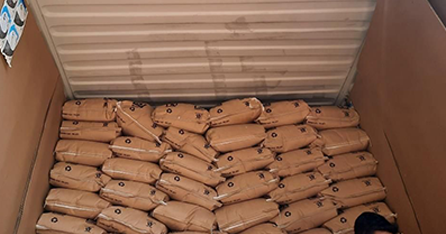
Shipping can present a wide range of challenges, especially when you’re dealing with chemicals. Certain chemicals need to be shipped separately from other substances, and they may be sensitive to extreme temperatures and other external factors. Choosing the right shipping container is important, but you also need to make sure you’re protecting your cargo with insulation.
Fortunately, EPGNA offers several solutions to help you safely ship bulk chemicals, food products, and other sensitive cargo. Our Hydry products protect your shipments from moisture by absorbing humidity, allowing you to safely transport moisture-sensitive cargo throughout the world.
If you want to make sure you’re transporting bulk chemicals safely, learn more about transporting bulk chemicals and how our Hybag and Hyblanket can help.
Bulk chemicals are chemicals that are stored in bulk containers. Although this term might sound subjective, bulk is actually defined in Title 49 of the Code of Federal Regulations:
“Bulk packaging means a packaging, other than a vessel or a barge, including a transport vehicle or freight container, in which hazardous materials are loaded with no intermediate form of containment. A Large Packaging in which hazardous materials are loaded with an intermediate form of containment, such as one or more articles or inner packagings, is also a bulk packaging. Additionally, a bulk packaging has:
(1) A maximum capacity greater than 450 L (119 gallons) as a receptacle for a liquid;
(2) A maximum net mass greater than 400 kg (882 pounds) and a maximum capacity greater than 450 L (119 gallons) as a receptacle for a solid; or
(3) A water capacity greater than 454 kg (1000 pounds) as a receptacle for a gas as defined in § 173.115 of this subchapter.”
So it all depends on the amount of chemicals you’re shipping. A bulk chemical shipment — whether it’s in the form of a liquid, solid, or gas — must meet the requirements outlined above. When you’re transporting bulk chemical shipments, there are specific regulations you have to follow.
While it’s safe to transport chemicals when you do it properly, there are several regulations and potential hazards to consider. You have to choose the right shipping container and follow protocol to safely ship bulk chemicals. You can also use our Hydry products to protect bulk chemical shipments from moisture, providing an added layer of protection for expensive bulk shipments.
You have to ship hazardous materials in a special type of container. Depending on the type of shipment you’re dealing with, you may need to mark your container as a fire hazard and use a special container that’s designed to protect your chemical shipment and prevent accidents.
For non-bulk shipments, you can store chemicals in a smaller container designed for chemicals within a larger shipping container. If you do this, you should use our Hypad or Hyblanket to absorb moisture within the shipping container, that way it doesn’t affect the chemicals.
The bottom line is that it’s safe to transport chemicals when you do it the right way. Following regulations and using the right shipping solutions can help protect your chemical shipments and prevent accidents.
There are lots of different chemicals that are shipped throughout the world on a regular basis. Some of these chemicals are flammable liquids while others are dangerous solids like dry ice. These chemicals have to be shipped long distances because they’re used all over the world. Some of the types of hazardous chemicals that are shipped via container include:
There are several types of hazardous chemicals you might consider shipping. Several chemicals you encounter on a daily basis are considered hazardous shipping materials. Knowing the chemical you’re shipping and its properties can help you safely transport chemicals.
Risks of Transporting Chemicals
The risks that come with transporting chemicals depend on the chemical you’re transporting. Spills are always a concern, but there are several ways to protect against potential spills. Certain chemicals may be sensitive to extreme temperatures or moisture. It’s important to understand the chemical you’re transporting and how it reacts to various environmental factors.
While spills are a risk when shipping hazardous chemicals, dangerous goods (DG) containers are an excellent way to protect against spills. DG containers protect against spills by acting as a sort of backup and catching any liquid that may spill out of a drum. DG containers also help by providing a tight seal that keeps chemicals from leaking out of your shipping container if they do spill. Of course, you still need to be careful about properly sealing chemical storage containers and safely stacking and storing containers. Alternatively, you can use a tank container to ship bulk chemicals in one large shipment.
There are dozens of chemicals that don’t react well to extreme temperatures, and some of them even become volatile when exposed to heat. When you’re shipping chemicals, make sure you understand how they react to changes in temperature. Certain chemicals must be labeled as a fire hazard when they’re being transported, and you may need to ship chemicals in a special type of container. Our Temcore products can help protect your cargo from extreme heat if you’re not required to use a special container.
Just like chemicals may react to changes in temperature, moisture can also affect certain chemicals. For example, sodium metal reacts with water to create a strong heat reaction, which can be a fire hazard. You can use various products — including our Hybag and Hyblanket — to protect against moisture and avoid chemical reactions. Our Hybag+ provides even more moisture absorption, giving you the best protection for moisture-sensitive shipments. These products are also great if you’re shipping food or other items that are sensitive to moisture.
Transporting chemicals safely is your responsibility, and it starts with following chemical shipping regulations. We can’t list every regulation in this blog post, so make sure you do your research and work with a qualified shipping company when you’re shipping chemicals. In addition to following safety regulations, here are some other tips for safely shipping chemicals.
Every chemical is different. Some chemicals react to heat while others react to extreme cold. Like we mentioned earlier, some chemicals even react with water. Before you ship chemicals, make sure you’re familiar with them. This will also help you figure out which regulations you have to follow, what kind of shipping container to use, and more. The more you know about your chemicals, the safer you can be.
If you’re required to use a special shipping container, make sure you choose the right type. You may be able to use a tank container if you’re shipping a bulk liquid. You may also be required to use a dangerous goods container to protect against spills. You can talk to the shipping company you’re working with to learn more about choosing the right shipping container and properly labeling hazardous chemicals.
For non-bulk chemical shipments, chemicals should be sealed tightly in drums and stored inside an appropriate shipping container. The important thing is making sure you’re properly sealing each drum and storing them the right way. The base you’re stacking the drums on should be flat and smooth, and you need to take your time to carefully stack drums to keep them from tipping over.
Are you transporting a chemical that reacts poorly to extreme heat or moisture? If that’s the case, you need the right container liner. Our Hydry products — including the Hybag and Hyblanket — are designed to absorb moisture to protect chemicals that are reactive with water. These blankets can also protect against spills to keep them from leaking out of the container. For temperature-sensitive cargo, our Temcore line of products provides powerful insulation.
Once you’re ready to send off your shipment, take your time to research and find a reputable company. Choosing a shipping company that’s familiar with transporting chemicals will make your life a lot easier. An experienced shipping company can even help you understand and follow chemical shipping regulations. When it comes to chemical shipping, you can never be too diligent.
Specialty shipping isn’t easy, particularly when you’re dealing with dangerous chemicals. There are several regulations to follow depending on the chemical you’re shipping, and you need to protect against spills and other incidents.
With the robust selection of shipping solutions EPGNA offers, you can safely transport everything from hazardous chemicals to fruits and vegetables. Our Hybag products protect against spills and keep moisture from damaging or reacting with chemicals. For temperature-sensitive shipments, our Temcore lineup provides the perfect amount of insulation for your pallet or shipping container. Simplify the chemical shipping process with Hybags, Hyblankets, and Hypads from EPGNA.

Sandra Malouf is the President of Eurolog Packing Group and has spent her career focused on Industrial Packaging. With a proven track record of helping businesses avoid supply chain disruptions, Sandra’s visionary leadership elevates the industry. She’s committed to developing sustainable practices and continues to shape the future of industrial packaging by listening to the customer and offering unique solutions applicable to various industries across the world. The company’s main focus is temperature stabilization and moisture damage prevention in exports affected by extreme variations in global temperatures.
© 2025 Eurolog Packing Group